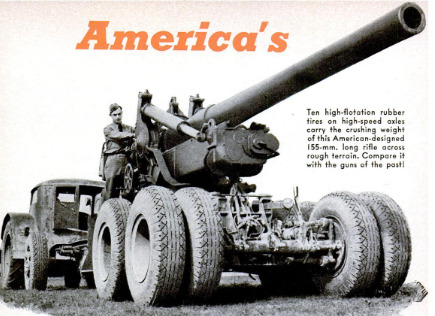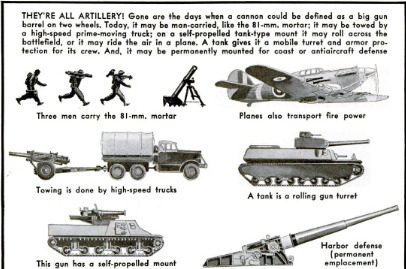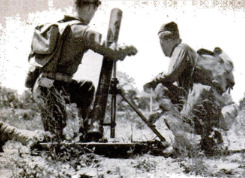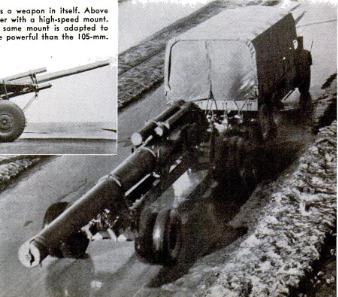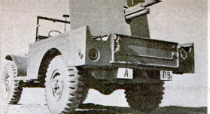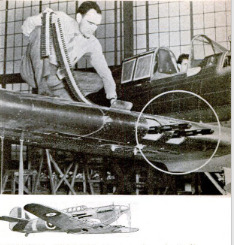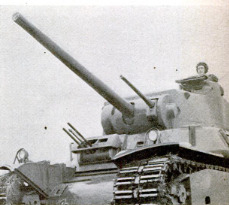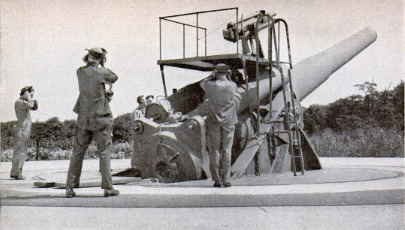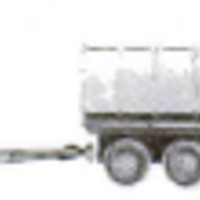-
Title (Dublin Core)
-
America's artillery might
-
Article Title and/or Image Caption (Dublin Core)
-
Title: America's artillery might
-
extracted text (Extract Text)
-
WE HAVE been hearing so much of
planes and tanks that the artillery
arm has been shoved into the publicity
background. Just the same, artillery re-
mains very much in the forefront of prac-
tical military thinking, and there is no sign
that it will diminish in importance as planes
fly faster and tanks get bigger. For that
matter, what is a bomber but a piece of fly-
ing artillery, with gasoline and gravity
propelling the projectile instead of gun-
powder? And when you mount a cannon
on a pair of caterpillar treads and surround
it with armor and a few machine guns for
close-up protection, isn’t it still a cannon?
For the present purpose, however, we
need not take in that much ground. Limit-
ing the argument to artillery in the con-
ventional sense, let us consider the composi-
tion of a typical German armored division.
Its chief striking power, of course, comes
from its tanks. But behind the tanks one
always finds a regiment of motorized artil-
lery, equipped with 105-mm. pieces, and
150-mm. as well. (25.4 mm. = 1 inch.) Like-
wise an antiaircraft-antitank battalion with
20-mm., 37-mm., and 47-mm. guns, usually
on self-propelled armored mounts. Artil-
lery protects the tanks during the assembly
period—nothing is quite as vulnerable as a
parked tank, unless it is an airplane on the
ground. During the attack an artillery
liaison officer rides in a tank in close prox-
imity to the tank battalion or regimental
commander. When anything untoward hap-
pens, such as the sudden discovery of an
antitank battery in a tankproof area where
it can fire on the flanks of the advancing
column, there is an immediate call for the
artillery to silence the AT guns from a safe
distance. Clearly, as far as the redoubtable
Nazi panzers are concerned, artillery is far
from an outdated arm.
For holding ground, and for a great deal
of ground-gaining, the Germans, like other
nations, still rely largely on infantry. What
then is the relation of artillery to infantry
in this, still the most successful of Euro-
pean armies in spite of its recent reverses?
“In the German Army,” writes one of their
colonels, “it is fundamental that no infantry
attack is to be carried out without artillery
support.” A German infantry regiment is
equipped with 12 AT guns, 27 two-inch
mortars, 18 three-inch mortars, six 2.95-
inch guns, and two 5.9-inch guns. The
divisional artillery is equipped with 36 105-
mm. howitzers, 12 150-mm. howitzers, and
other large pieces. Artillery observers stick
close to the infantry commander, maintain-
ing contact with their batteries by radio
and supplying help promptly wherever
needed.
Our own Army has studied the lessons
of the European campaigns very carefully
and here is the result as far as artillery is
concerned: The square infantry division
(four regiments) is supported by a field-
artillery brigade of three regiments which
carries 48 105-mm. howitzers and 24 155-
mm. howitzers. The triangular infantry
division (three regiments) has proportion-
ate numbers of the same weapons. The
armored division supports its 390 tanks
with 57 60-mm. mortars and 27 81-mm.
mortars, as well as 194 37-mm. towed AT
guns; 42 75-mm. and 54 105-mm. howitzers,
all self-propelled. Obviously our general
staff relies on artillery to a considerable
extent to win the war, and it is scarcely
likely that American artillerymen will have
any reason to complain that they are in a
branch of the service where a man has no
chance to show his mettle.
All the weapons thus far mentioned were
used in World War I. That is, the calibers
and classifications were the same. But
when we examine the individual pieces in
more detail, we find a great improve-
ment in fire power, mobility, and ac-
curacy. The rate of progress is not
as striking as in the case of the air-
plane, but then the airplane is not yet
50 years old, while cannon date back
to the thirteenth century.
The humble but invaluable trench
mortar is a good example of the ad-
vances made in the last 20 years. A
mortar is simply a light steel tube set
on the ground pointing skyward, and
supported in front on two legs, form-
ing a tripod. Usually it is muzzle-
loaded: the shell is dropped into the
tube, the propellant charge in the
base of the shell is exploded by a fir-
ing pin, and the projectile sails out
considerably faster than it went in.
But not very fast as shellfire goes—if
a modern pursuit plane took off from
the muzzle at its normal speed just
ahead of the shell, the latter would
not quite catch it. The trajectory
of the mortar projectile is like a lob
in tennis, high and slow, and, like the lob,
it can be extremely annoying when well
placed.
The familiar Stokes mortar of the first
‘World War proved that much, in spite of
the fact that, being a smoothbore weapon,
it had no means of preventing the projectile
from tumbling end over end on its course.
This not only increased the drag and short-
ened the range, but, since no two projectiles
tumbled in the same way, dispersal of
shots was great. The modern mortar fires
an elongated, tear-shaped projectile equipped
with tail fins to keep it pointed on its
course. As a result of this and other im-
provements, it has become a much more
formidable weapon. The following table
shows how it compares with the World
‘War I model:
Trench Mortars
in. Stokes 60-mm.M-2 S1-mm. M-1
‘Weight of projectile, (3.24n.)
pounds 12 3 6.9 and 15.01
Maximum range. yds. 750 1.935 3,290 and 1,275
Weight of mortar in
firing position, pounds 110 “2 136
Thus the modern 81-mm. mortar, with
caliber slightly larger than the Stokes and
firing a projectile 3.01 pounds heavier, has a
range 70 per cent greater, and higher ac-
curacy for a given range. At the same time
the piece is only 26 pounds heavier. The
smaller 60-mm. mortar, with a range of
over a mile, weighs 42 pounds and can be
carried by one man. With all the other
developments simultaneously taking place,
one can never predict how important such
improvements may prove to be in a modern
war. A light cannon is just what the doctor
ordered for air artillery. Each German
parachute battalion is liberally equipped
with 75-mm. guns, 8l-mm. mortars, or
mine-throwers, as the Germans call them,
and an abundance of 50-mm. mine throwers.
This is in addition to each parachutist’'s
personal armament of automatic pistol,
hand grenades, and dynamite sticks. !
The larger cannon classed as field artil- |
lery likewise reflect the results of research
in ballistics, gun manufacture, the chem-
istry of explosives, and all the other techni- |
cal arts that go into armament production.
Field pieces are divided into guns and how-
itzers, the latter being distinguished by |
their short barrels and higher elevation. |
For a given caliber the gun will have a |
longer barrel, higher muzzle velocity, and,
as a rule, longer range. The distinction
between the two types is becoming less |
sharp as gun elevations increase, while at |
the same time howitzers are acquiring
higher muzzle velocities and longer ranges.
One consequence is that the 105-mm. how-
itzer is now largely replacing the 75-mm.
gun in our Army, in spite of great improve: |
ments in the latter. A 75-mm. gun of 1918
design was limited to a six-degree traverse
or side-to-side swing without shifting the
trail. By means of a_split-trail arrange- |
ment the traverse has been increased to 85
degrees, or almost a right angle, and the
maximum elevation has gone up from 19 to
45 degrees. Partly through the higher ele-
vation, the range has been increased from
9,700 to a maximum of about 13,000 yards, |
and mobility has been greatly improved by
mounting the piece on a high-speed car-
riage. But the 105-mm. howitzer is prac-
tically as mobile; it weighs 4,300 pounds— |
only 500 pounds more than the 75-mm. gun,
and can be towed by a 2 1/2 -ton truck. Fir.
ing on its own wheels, it is practically
ready for action when it stops rolling. It
has about the same range as the 75-mm.
gun, but the big advantage of the howitzer
is that it throws a 33-pound projectile in-
stead of the 15-pound shell of the 75. A
piece which can deposit twice as much TNT
on the enemy per shot is obviously to be
preferred, and that is why the 105-mm.
howitzer is getting a bigger share of the
business in the present war.
For more oomph, the artillery goes up to
the 155’s. The howitzer weighs only 9,000
pounds and, equipped with air brakes and
pneumatic tires, can be drawn by a truck
at 50 m.p.h. on a good road. Once it gets
there it can be emplaced in a few minutes.
The 155-mm. howitzer fires a 95-pound shell,
as does the gun of the same caliber. The
gun has double the range—25,000 yards as
compared with 12,400 for the howitzer.
This gun is really a heavy piece—15 tons—
and it requires a truck or tractor of about
the same weight to move it. Beyond the
155's we get into the really big field artil-
lery, like the 8-inch and 240-mm. calibers,
some mounted as railroad guns.
One might imagine that guns weighing
10, 20, and 40 tons with their tractors, and
necessarily presenting problems when it
comes to crossing bridges, traversing under-
passes, traveling on two-lane roads, etc.
would have been superseded by the bomber
by this time. But once a big gun has been
strategically sited and has got the range it
can pound a target with an accuracy far
exceeding that of the best bombers. As a
siege weapon against cities and fortifica-
tions it still has no equal. It can make a
vital enemy position absolutely untenable
and do terrible damage to any body of
troops which tries to stand up against it
without equivalent fire power.
The allocation of artillery to bodies of
troops is something like a banking system.
The smallest pieces are part of the organic
equipment of platoons and companies of
infantry. The 105 is a divisional arm, the
155 both division and corps. Bigger guns
are assigned by GHQ as required. GHQ
would correspond to the Federal Reserve,
the small infantry units to the country
banks; in between there are the metro-
politan banks with their larger resources.
Any group may requisition or borrow ar-
tillery from a higher echelon—if it can get
it. As in the money market during a
financial crisis, the would-be borrower does
not always find a willing lender. |
The advances in field artillery, notable as
they are, have been overshadowed by ad-
vances in antitank and antiaircraft guns.
This was a matter of military necessity. |
Every weapon has its counterweapon, and
the development of one compels the devel-
opment of the other. In the first World War
it was found that the machine gun had |
made the defense too strong. Infantry
could no longer advance except at fearful
cost. The tank was evolved to cope with the
machine gun. The antitank gun was then |
pitted against the tank.
Actually the surest defense against the |
tank is another tank, preferably a bigger
one. But an antitank gun costs only about |
a tenth as much, in manpower and ma-
terials expended in manufacture, and thus
fills a definite need. Since it often accom-
panies infantry it must be as light and
small as possible. The effective range need
not exceed 1,200 yards, but the trajectory
must be flat so that tanks cannot roll
underneath as they close in. A flat tra-
jectory means high muzzle velocity and a |
relatively small shell.
The 37-mm. AT gun, which represents a
good compromise between these require- |
ments, is mounted
on a carriage of the split-trail type, which
affords a wide traverse without shifting the
mount. The weapon is easy to aim and op-
erate. It is normally designed for visible fire
and direct laying or aiming: the gunner,
that is, has direct control of the weapon and
does not rely on any mechanical device to do
the pointing for him. “The rate of fire is 15
to 20 rounds a minute under combat con-
ditions.
The 37-mm. gun is effective against light
tanks. It cannot stop medium and heavy
tanks unless it scores a hit through an open
port, or damages a tread or track suspen-
sion. For protection against these larger
tanks a 75-mm. gun is needed. The biggest
tank so far built can be disabled by a well-
placed shell from a 75-mm. gun.
‘When mounted on a tank chassis or half-
track weapon carrier, and provided with a
shield for the crew, either the 75-mm. or
37-mm. gun is called a “tank destroyer.”
The combination really constitutes a tank
in which armor protection has been sacri-
ficed for lightness and speed. Such a vehicle
must traverse rough terrain, plow through
soft places, ford streams, climb out of
ditches and shell holes, and in general
cover ground almost like a horse. The
chassis must not be so low that it will
strike ordinary obstructions, nor so high
that the body will present an easy tar-
get. The power plant must be big, the
armor as heavy as possible, yet the combi-
nation must not be too heavy to get around
‘with speed and certainty.
very low silhouette to make it hard to hit.
A jeep or an armored half-track might
take a shot with ordinary gun sights at a
low-lying plane and bring it down, but
that would be something to write home
about. For antiaircraft work, special guns
and aiming means are employed, because
the target is moving so rapidly that the
unaided human eye and brain are inade-
quate. The essential difference is in the
method of fire control—of which more later
—rather than in the gun itself. Thus the
antiaircraft battery can be and often is
used against tanks and armored cars with
great effectiveness. In fact, the service
regulations require the crew to be prepared
for such operations. But, while an AA gun
automatically becomes an AT gun when
the muzzle is pulled down and it i aimed
by eye, an AT gun cannot be used for AA
fire uniess it ls especially equipped for that
service. We now have some 37-mm. guns
on half-track carriers which are so equipped
and can bo switched instantaneously from
AT to AA shooting.
The standard sizes of AA guns in our
Army at the present time are 37 or 40-mm.,
3-inch, and 90-mm. for mobile service. Still
larger guns are being manufactured for use
in semifixed emplacements. As always, the
design requirements conflict. An AA gun
should have a high rate of fire, high muzzle
velocity, as straight a trajectory as possi-
ble, the lowest possible time of flight, and
large bursting area for the projectile. But
an the size of the gun increases the rate
of fire drops. Likewise, high muzzle ve-
locity requires a thick-walled shell, which
reduces the burst effectiveness. Mobility
calls for a small gun and high-altitude ef-
foctiveness for a big one. The result is that
no one gun will fulfill ll the requirements,
and several calibers and types are necessary
10 do the job right.
For low-flying planes—say up to 5,000
feet—the 37-mm. or 40-mm. gun is reason-
ably effective. The latter is the famous
Bofors funnel-shaped design which has
been thoroughly tested in Europe. It is
fully automatic and fires up to 120 rounds
a minute. The projectile weighs 2.2 pounds
and will explode on contact with an air-
plane wing. The muzzle velocity of 2,850
feet per second gives the gun a virtually
straight trajectory to a range of about
9,600 feet. The weight of the gun happens
to be the same as that of the 105-mm. how-
itzer—4,300 pounds—and it can be put into
action within half a minute after arrival
The next larger caliber, 3 inches, makes
a much heavier AA gun-—12,000 pounds—
but one which is still readily transportable.
Set up, the gun, mount, and working plat-
form rest on four sectionalized outriggers or
horizontal girders laid on the ground. This
contrivance folds up for transportation and
takes from seven to ten minutes to em-
place. The muzzle velocity is almost as
high as that of the Bofors, but the rate of
fire is down to 25 rounds per minute. On
the other hand, the projectile weighs over
five times as much—12.7 pounds. A gun
of this caliber is reasonably effective up to
15,000 and possibly 18,000 feet. It is valu-
able in the field and for protection of tar-
gets requiring precision bombing.
The data on the larger AA guns, 90-mm.
and 4.7-inch, is restricted. However, it is
safe to assume that our 90-mm. is superior
to the German 88-mm. gun, which fires 20
rounds per minute and has an effective al-
titude of about 25,000 feet. The 90-mm.
gun travels on a single-axle trailer, towed
by a six-ton truck. It is the largest mobile
size in AA guns. The 4.7-inch is too heavy
to be considered fully mobile. A gun of this
caliber, intermediate between the 105 and
155-mm. field piece, is heavy and expensive
to build, and expensive to fire, but one of
its shells may dispose of a plane several
hundred feet from the bursting point, and
the bursting point is somewhere up in the
substratosphere. Where a gun like this is
emplaced, the bombers fly high and bomb
less accurately, if they bomb at all.
One thing the machine cannot do, how-
ever, and that is to make the decisions. That
1s still a man’s job. The greater the extent
of military mechanization, the more impor-
tant intelligence, will, initiative become.
And in these qualities the artillery arm
ranks high. There is nothing more impor-
tant than artillery in this war—unless it is
the artilleryman.
-
Contributor (Dublin Core)
-
Carl Dreher (article writer)
-
Language (Dublin Core)
-
Eng
-
Date Issued (Dublin Core)
-
1942-07
-
pages (Bibliographic Ontology)
-
54-60, 210,212,215
-
Rights (Dublin Core)
-
Public domain
-
Archived by (Dublin Core)
-
Sami Akbiyik
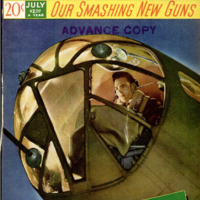 Popular Science Monthly, v. 141, n. 1, 1942
Popular Science Monthly, v. 141, n. 1, 1942


